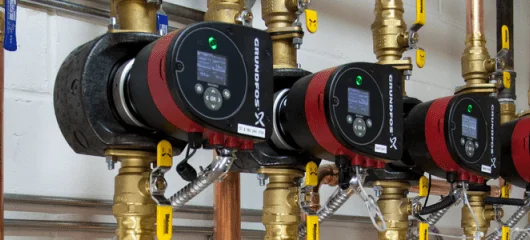Why does it seem we are hearing a lot about dirt in hydronic systems lately? “Dirt” can mean ferrous metal particles, hard water deposits, metal shavings, solder, weld slag, sealing tape, even actual dirt and other things that find their way into the piping before it gets installed. All this dirt interferes with the operation of valves, circulators, flowmeters, anything with moving parts and heat exchangers.
Today’s high-efficiency hydronic system components could be the reason dirt has become such a popular topic. For example, dirt is less of a concern for a high-mass, low pressure drop cast iron boiler, but it’s a major concern with today’s low-mass, high pressure drop modulating condensing boilers. Just 1 mm of scale buildup on a heat exchanger can reduce efficiency by a whopping 10%! The heat exchanger water passages are small; it doesn’t take much dirt to completely clog one of these new boilers.
A related hot topic is the question of whether or not metal particles such as iron oxides are building up near the permanent magnets found in today’s ECM (electronically commutated motor) pumps. If so, is it affecting the life expectancy and efficiency of these high-efficiency pumps? In an ECM pump, the magnetic field is always present, not just when the motor is energized, as is the case with traditional PSC (permanent split capacitor) motors. Is this a problem? Are magnetic technology dirt separators the solution? Like I said, it’s a hot topic.
A well designed and properly installed/maintained hydronic system should contain very little dirt. We recommend:
→ NOT filling the system with untreated “hard” water (a topic for another article) and
→ INSTALLING a Caleffi DIRTCAL®, DIRTMAG®, DISCALDIRT®, or DISCALDIRTMAG® dirt separator
If your project includes primary/secondary piping, it needs hydraulic separation as well. In that case, check out the new, 4-in-1 SEP4™ hydraulic separator with air, dirt and magnetic separation for the ultimate in performance and lowest total installed cost.
We've got several videos that you may want to take a look at to help you in understanding dirt elimination:
↓ Combo Air, Dirt & Hydraulic Sep ↓ Combo Air & Dirt Seps ↓ Dirt & Magnetic Seps
For an indepth look at fluid quality and its effect on hydronic systems, it would be remiss of me if I did not share with you the following webinars from our Coffee with Caleffi archive: 1) Jeff Person's Fluid Quality and Its Consequences and 2) Air, Dirt and Pump Conflict.
Stay tuned,
Kevin Freidt







One of the questions that has not been answered with magnetic separation and with ECM motors is the electromotive potential that can be created. As an engineer, we know how a motor works: create a magnetic field and pass a conductive material through it, an electrical potential is created that becomes an electrical current.
This is one good reason for using distilled water and glycol in a heating system; to make the fluid (water) as non-conductive as possible.
In reply to One of the questions that has by James Poehling
Jim, interesting point. Maybe one of the ECM pump guys will have a reply. But in the meantime, we are fans of using demineralized water. I think there is going to be a lot more focus on water chemistry here in North America - much confusion is out there - even in the specifying community. RPA had a great webinar yesterday on water quality. Guy from Switzerland did good job. Did you attend? If no, maybe we can send you a link when they archive it.
In reply to Jim, interesting point. Maybe by Mark Olson
The days of install and forget are over.
Now that we are into 95% efficient boilers and ECM pumps, water chemistry will become an increasingly large issue.
Manufacturers are no longer going to warrent plugged boilers or frozen pumps because the water quality is bad. Speaking as a wholesaler, we won't accept the expense of replacement. The contractor will be stuck with resolving the problem at his own expense.
The day of continuous pressure (fill) valves will fast be coming to an end.
Systems will need demineralized (distilled) water that has been treated with oxygen scavengers and minimal pH modification. LWCO will replace the fill valve and proper water treatment will be necessary for any added water in the system.
If a system is correctly installed, the fill valve will never actuate. The purpose of the fill valve goes back to the days of "packed seal" pumps where the librication for the seal was a drop of water a minute dripping out of the seal. Now the pumps have no seals what so ever. The need for the fill valve is gone. Arise world and end the tyranny of the fill valve in hydronic systems! (OK a little over the top).
In reply to One of the questions that has by James Poehling
Hi fantastic website.
In reply to Hi fantastic website. by blackzero0
Thanks for your comments.
About your point about scale, here is a failed fire tube type boiler from untreated Chicago municipal water. Scale is thickest where the metal is hottest.
Maybe a bigger issue with iron oxide is it is so hard to filter or separate out of the fluid and eventually settles somewhere and builds up. Boiler manufacturers know a result could be plugged heat exchangers. Here's a photo from Texas showing a failed boiler section due to the water tube being completely clogged by iron oxide.
I received a powerpoint presentation from Grundfos Pump Co about iron oxide and their pumps.
For the past 30 years, they have tested their pumps for magnetite contamination and do not release any design for production if they do not pass an accelerated 15 year test.
They also reference the German Standard for water quality for boilers VDI-2035.
Put into English terms
Conductivity 50 micromho/ in (high purity water, basically RO water with oxygen scavengers added)
Cloudiness 0 (no suspended particles in the water)
8.2 to 10 pH water that has been chemically treated to raise the pH
oxygen level 0.5ppm ( most city water is about 7.0 ppm) water has been treated with an oxygen scavenger
Putting "pure" water in the system is to no avail if the system was not first cleane and flushed prior to adding the water.
I would like to know if Caleffi will be adding sizes to the current 5461 Brass air and dirt separators. Threaded sizes in 1-1/4", 1-1/2", and 2" would be nice as many older steel pipe systems and residential steam retrofits need these sizes.
In reply to I would like to if Caleffi by Erin Deibert
We are looking at these; a larger body is available and we know there is a bit of a gap with those threaded sizes.